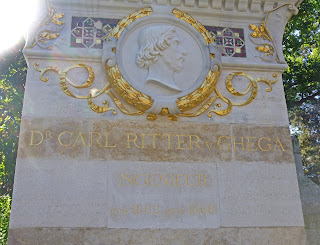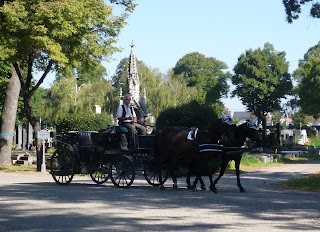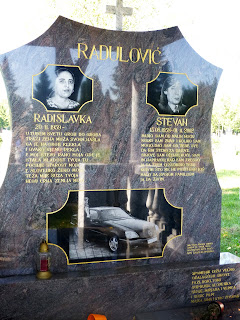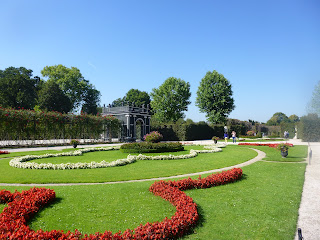Saturday 15 September : Trainjourney from Passau to Vienna (3h)


Kate meets me at the Franz-Jozefs-Bahnhof.
She has recently moved into a new apartment in Hirschstetten, northeast from the Vienna city center, with a very easy metro access..
Hirschstetten is famous for its Botanial Gardens.
On Sunday 16th we visit the Belvedere palaces
 |
| Oberes Belvedere |
He chose one of the most outstanding Baroque architects Johann Lucas von Hildebrandt (1668-1745).
 |
| Unteres Belvedere |
Momentous events have taken place in the Upper Belvedere’s Marble Hall and from here there is a spectacular view of Vienna.

We visited the exhibition "Orient & Okzident" (Österreichische Künstler auf reisen) in the Lower Palace.
Unfortunately it was forbidden to take photo's. (the following are scans from the brochure°
 The afternoon we go to the Museum Quartier
The afternoon we go to the Museum Quartier
and visit
Mumok
Museum Moderner Kunst Stiftung Ludwig Wien
From the outside, the building appears like a dark, closed block, its roof curving down low on the edges. It is monolithically clad in anthracite grey basalt lava on the façades and roof surfaces: thus it is clearly set apart from the adjacent level and seems to emerge from the deep.
The Museum of Modern Art in the MuseumsQuartier focuses its attention on the art of the 20th and 21st centuries. Works by Andy Warhol, Claes Oldenburg, Pablo Picasso, Yoko Ono, Günter Brus and Gerhard Richter invite visitors to engage with contemporary art.
Reflecting Fashion. Art and Fashion since Modernism.
 |
| Schiaparelli |
The exhibition focuses on clothing and fashion as an
essential component of art, where particularly since the mid-1960s they have
played a major role in the work of such artists as Ellsworth Kelly, Cindy
Sherman, Niki de Saint Phalle and Daniel Buren.
Fashion has always played an important role in the
semantics of modernism, with numerous traditions following Baudelaire in
defining “modernité” through a concept of fashion - of what is “à la mode”.
During the early 20th century, fashion became
part of the formal language of the avant-garde including such artists as Sonia
Delaunay, the Futurists and the Surrealists.
 |
| Christo "Wedding-Dress" |
 When Vienna grew into a city of more than one million inhabitants, the old cemeteries of the various districts became to small. To accommodate the growing capital, the Central Cemetery, with an area of about 495 acres, was opened in 1874.
When Vienna grew into a city of more than one million inhabitants, the old cemeteries of the various districts became to small. To accommodate the growing capital, the Central Cemetery, with an area of about 495 acres, was opened in 1874.
"Friedhofskirche zum heiligen Karl Borromäus"
(Church of St. Borromeo), which is crowned by a large dome. The church, built by Hegele between 1908 and 1910, serves as the cemetery church and mausoleum of Lueger, the mayor of the city from 1897 to 1910.
 Carl Ritter von Ghega (10 January 1802 – 14 March 1860) was the most prominent of Austrian railway engineers and architects.
Carl Ritter von Ghega (10 January 1802 – 14 March 1860) was the most prominent of Austrian railway engineers and architects.

Among many others, Gluck, Beethoven, Schubert, Hugo Wolf, Johann Strauss Father and Son, Lanner and Brahms are buried in Group 32a
 |
| Hugo Wolf, Austrian composer of Slovene origin, particularly noted for his art songs, or lieder |
 |
| Franz von Suppe |

August Zang (1807 – 1888) was a nineteenth-century Austrian entrepreneur and banker, best known for founding the Viennese daily "Die Presse"
In the evening we go to Monteverdis opera "Il ritorno d'Ulisse in patria"
in Theater an der Wien.
 |
| Front side |
 |
| Garden side |
The former Imperial country residence was one of the most glorious palaces in the Habsburg lands. In 1726 it was acquired by the legendary general Prince Eugene of Savoy who had it completely redesigned so that it later became the largest country palace estate under the reign of the Empress Maria Theresia.
The Baroque gardens are magnificent.
The Baroque gardens are magnificent.
Sited at the foot of the hill behind the palace and designed as the crowning element of the Great Parterre is the Neptune Fountain. It was conceived as part of the overall design of the gardens and park commissioned by Maria Theresa in the 1770s.
 Situated in the middle of the woods on Schönbrunn Hill near the Maria Theresa Gate lies the Small Gloriette, a tower-like two storeyed pavilion which was built around 1775, probably to designs by Isidor Canevale. The octogonal structure with its balconies and built-on stairwell was probably used as a viewing pavilion.
Situated in the middle of the woods on Schönbrunn Hill near the Maria Theresa Gate lies the Small Gloriette, a tower-like two storeyed pavilion which was built around 1775, probably to designs by Isidor Canevale. The octogonal structure with its balconies and built-on stairwell was probably used as a viewing pavilion. 
The interior is decorated with Rococo architectural murals which on the second floor open up above a balustrade into a painted sky.
 The Schönbrunn zoo is the oldest
The Schönbrunn zoo is the oldest still in existence, and one of the most beautiful in the world, Schonbrunn Zoo has a lot offer its visitors. It has survived the two World Wars and is now home to some of the rarest, most interesting animals on Earth.
It was followed by lions and wild bears, and at the beginning of the 19thcentury, the zoo hosted polar bears, hyenas, kangaroos, tigers and even a giraffe.
Emperor Joseph II himself conducted expeditions to Africa and the Americas to bring new species to Schonbrunn, for the entire world to see.
The zoo was home to over 700 species and 3,500 specimens at the beginning of World War I, but the food shortages and the dissolution of the Austrian Empire took their toll and the number of specimens dropped at 900.

During WW2, Schonbrunn was devastated by bombings, and the numbers of animals dropped to 400. Fortunately, thanks to good management, Schonbrunn Zoo managed to overcome its difficulties and is now one of the main tourist attractions in Vienna.
The zoo was home to over 700 species and 3,500 specimens at the beginning of World War I, but the food shortages and the dissolution of the Austrian Empire took their toll and the number of specimens dropped at 900.

During WW2, Schonbrunn was devastated by bombings, and the numbers of animals dropped to 400. Fortunately, thanks to good management, Schonbrunn Zoo managed to overcome its difficulties and is now one of the main tourist attractions in Vienna.
 We return to town for a visit to the Albertina, where we want to see the exhibition on Emperor Maximilan and Dürer.
We return to town for a visit to the Albertina, where we want to see the exhibition on Emperor Maximilan and Dürer.
The Albertina is the largest Habsburg residential palace. The city’s largest residential Habsburg palace boasts 21 beautifully furnished staterooms, making it one of the most exquisite classical palaces in the whole of Europe.
Since it reopened in 2003, the Albertina has presented an impressive number of exhibitions, showing foremost works of art dating from the 15th century to the present day. With its special “Albrecht Dürer”, “Picasso” and “Van Gogh” exhibitions, the Albertina has drawn a record number of visitors during the past few years.
 The Albertina celebrates art produced under the rule of the mediaeval emperor Maximilian I, once referred to by historians as the "Last Night".
The Albertina celebrates art produced under the rule of the mediaeval emperor Maximilian I, once referred to by historians as the "Last Night".Maximilian commissioned many of the works currently on show in Vienna from leading artists of the day such as German painters Albrecht Dürer and Albrecht Altdorfer.
The exhibition examines the influence and contribution Maximilian made to the art world, with many of the works on display coming from the Albertina's collection while other paintings are on loan from major international museums.
During his reign as Holy Roman Emperor, Maximilian set about creating a revival of chivalry and knight-associated activities such as jousting tournaments throughout Europe
 For my last evening we meet with friends of >Kate in Café Sperl, one of the 54 Coffeehouses
For my last evening we meet with friends of >Kate in Café Sperl, one of the 54 Coffeehousesthat participate in "Kriminacht" ( Crime Night) , a literary event which takes place tonight for the 8th time with 81 actors and 63 readings.

 In Café Sperl Dieter Chmelar In Café Sperl Dieter Chmelar and Peter Rapp read from Agatha Christie.
In Café Sperl Dieter Chmelar In Café Sperl Dieter Chmelar and Peter Rapp read from Agatha Christie.
The next morning I have to get up very early for my taxi to the station to catch my 6:40 train to Brussels via Frankfurt, Bonn, Köln, Aachen and Luik, a long journey.




































































































